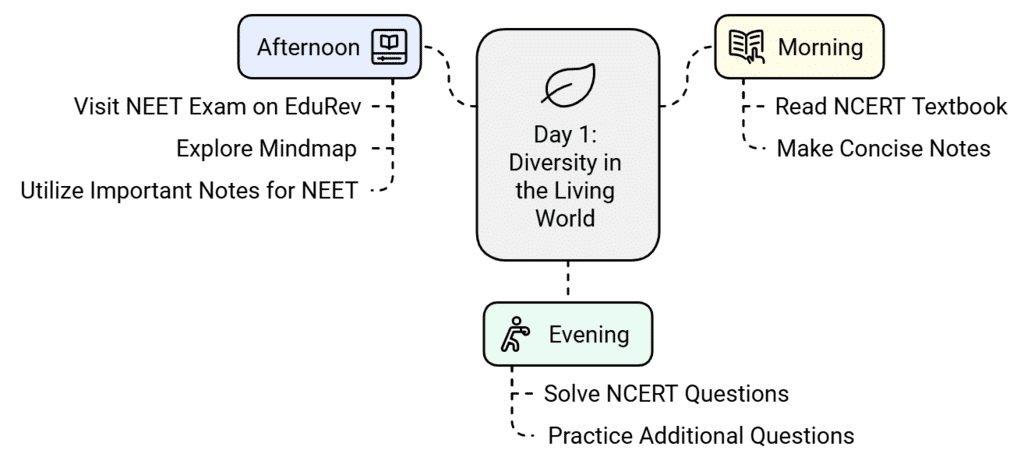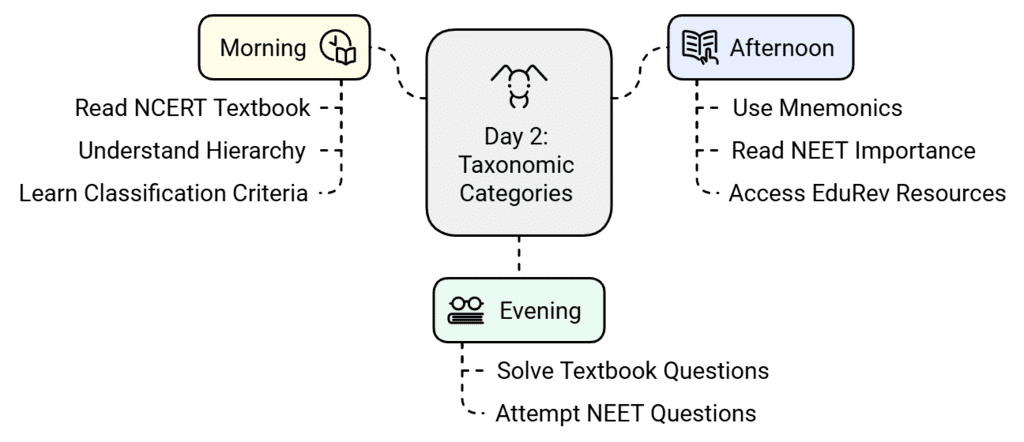2 Days Study Plan: The Living World | Biology Class 11 - NEET PDF Download
| Table of contents |

|
| Meeting Your Timetable Goals with EduRev! |

|
| Chapter Overview |

|
| Day 1: Diversity in the Living World |

|
| Day 2: Taxonomic Categories |

|
| Revision & Practice |

|
Let's explore the Biology chapter called "The Living World" and how it's important for the NEET exam. By studying the past years NEET questions (from 2016 to 2025), we can see that this chapter is really important in the exam. Understanding the concepts in this chapter is crucial for success in the NEET exam as it lays the foundation for understanding biodiversity and taxonomy, which are essential topics in biology.
Meeting Your Timetable Goals with EduRev!
The study plan for this chapter offers you a schedule to manage your time effectively for learning and practicing the chapter thoroughly. By following this plan diligently, you'll be well-prepared to tackle even the most challenging questions asked in NEET related to each chapter. EduRev makes your preparation easier and saves you time by providing comprehensive resources for each topic. These resources include chapter notes, videos, and tests for every topic and chapter.
To access these valuable resources, including documents, videos, and tests, simply click here.
Chapter Overview
"The Living World" chapter in Class 11 Biology covers two main topics:
Let's create a study plan to efficiently cover these topics over a span of 2 days, with an additional day dedicated solely to revision.
Recommended Tip: Review the past year's questions related to this chapter. This will provide you with insights into the types of questions typically included in the exam and the level of detail you need to study. Getting a sneak peek ahead of time can be a game-changer!
Day 1: Diversity in the Living World

Morning
Start by reading the relevant sections from your NCERT Biology Class 11 textbook. Pay close attention to the definitions, concepts, and examples provided.
After reading, make concise notes summarizing the key points related to diversity in living organisms.
Afternoon
Visit NEET Exam on EduRev for an overview of the importance of this chapter in the NEET exam.
Explore the Mindmap on "The Living World" to get a visual representation of the chapter's main concepts.
Utilize Important Notes for NEET on EduRev for additional insights and examples related to diversity in living organisms.
Evening
Solve the questions provided in the NCERT textbook related to this chapter.
Practice additional questions available on EduRev, focusing on diverse examples of living organisms to strengthen your understanding.
Day 2: Taxonomic Categories

Morning
Begin with a thorough reading of the taxonomic categories section in your NCERT textbook. Understand the hierarchy of classification and the criteria used for classification.
Afternoon
Refer to Mnemonics for The Living World on EduRev for helpful memory aids to remember taxonomic categories.
Read about the importance of taxonomic classification in the NEET exam on the NEET Exam page.
Take advantage of the EduRev platform to access additional resources, including questions and solutions related to taxonomic categories.
Evening
Solve the taxonomic category-based questions from the NCERT textbook.
Test your knowledge by attempting the NEET Previous Year Questions (2016-23) related to this chapter to get a feel for the types of questions asked in the NEET exam.
Revision & Practice
 Morning
Morning
Review your concise notes from Day 1 and Day 2, focusing on key definitions, examples, and important concepts.
Use the provided Mindmap to quickly recap the main points of the chapter.
Afternoon
Go through the questions you've practiced from both the NCERT textbook and EduRev. Pay attention to any topics where you might need further clarification.
Evening
Discuss any doubts or difficult concepts with your peers or a mentor if needed.
Take a final mock test on the chapter to assess your understanding.
In the NEET exam, you'll encounter questions like the ones mentioned in below links. The best way to review and get better at the topics is to solve the questions. If you find a question tricky, it's a sign that you might not fully grasp that topic. In that case, it's a good idea to revisit the topic and study it again and solve more and more questions related to it.
- NEET Previous Year Questions (2016-23): Living World
- NCERT Based Tests
- Assertion and Reason type questions
- Short & Long Answer type Questions
- Topic Wise tests
- Case Based Questions
Important Links of the Chapter:
- NEET Exam
- NEET Previous Year Questions (2016-23): The Living World
- Mindmap: The Living World
- Mnemonics for The Living World
- Important Notes for NEET: The Living World
- Chapter Link
- Taxonomy: Identification, Nomenclature & Classification
- Taxonomical Categories & Taxonomical Aids
- What is Living & its Characteristics
By following this comprehensive study plan and making the most of the EduRev platform's resources, you'll be well-prepared to tackle the "The Living World" chapter in Class 11 Biology and excel in the NEET exam. Good luck with your studies!
|
150 videos|399 docs|136 tests
|
FAQs on 2 Days Study Plan: The Living World - Biology Class 11 - NEET
| 1. What is the significance of diversity in the living world for NEET preparation? |  |
| 2. How are taxonomic categories organized and what are their levels? |  |
| 3. What are some common examples of organisms used to illustrate diversity in the living world? |  |
| 4. How can I effectively revise the concepts of diversity and taxonomy in a 2-day study plan? |  |
| 5. What role does practical knowledge play in understanding the living world for NEET? |  |
















